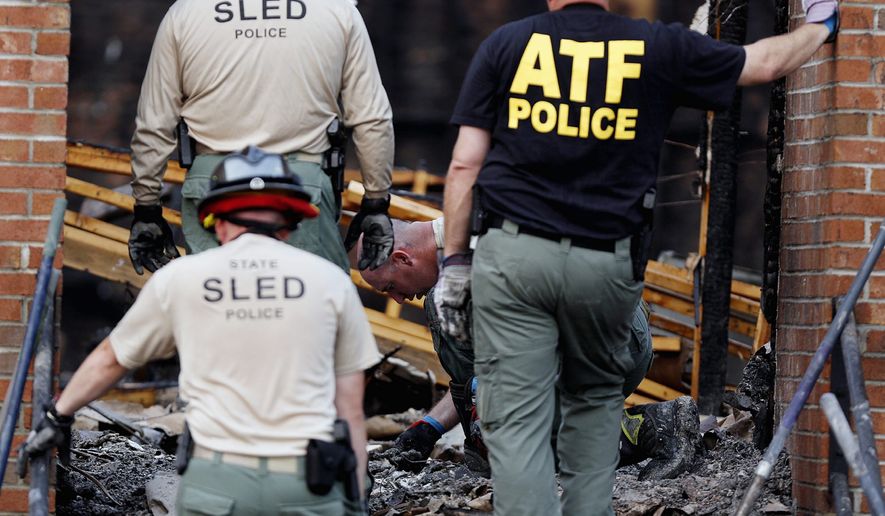A string of fires at black churches in Southern states have sparked concerns that racial friction has spiked in the aftermath of the racially-motivated mass shooting at a church in Charleston, South Carolina.
Federal fire investigators are combing through the remains say they do not have enough evidence on hand to determine that the scattered incidents were racial attacks against the black population. Additionally, it does not yet appear that any of the fires are connected, said Bureau of Alcohol, Tobacco, Firearms and Explosives spokeswoman Ginger Colbrun.
“We don’t believe they’re racially motivated or related,” she told The Washington Times. “I mean, if you go back and look at some of these circumstances, everyone is just lumping them in as one and that’s not good. There’s no linkage at this time.”
Those investigators are gathering information on the fires that took place in southern churches, which began going up in flames in the days following the June 17 mass shooting.
To date, their investigation has grown to include the Greater Miracle Temple Apostolic Holiness Church in Florida; God’s Power Church of Christ in Georgia; Glover Grove Baptist Church and Briar Creek Road Baptist Church in South Carolina; and Fruitland Presbyterian Church in Tennessee; according to a June 30 ATF statement.
Nearly 1,800 church fires occur every year — almost five per day; though that figure includes churches of all ethnicities — among the 300,000 structure fires in the U.S., said John Lentini, president of Scientific Fire Analysis LLC, who has conducted thousands of fire-scene inspections.
SEE ALSO: Charleston shooting latest in a history of deadly attacks on black churches
According to a 2013 estimate by the National Fire Protection Association, about one-sixth of all fires at churches and other religious buildings turn out to be arson. And a task force established by President Clinton in the 1990s noted that about one-third of the attacks on black churches resulted in arrests of black people and the motives of arsonists and bombers of all ethnicities varied and often weren’t race-related — vandalism, burglary, cover-up and personal grudges, for example.
But some fire experts say the timing of these last seven or so fires is too suspicious not to be connected. Someone out there is trying to scare the black community, Mr. Lentini said.
“They want the black parishioners to be afraid,” he said. “That’s what they’re doing. They’re trying to instill fear in the black community by burning down their churches.”
The Rev. Donte Hickman, one of the many people urged by police to flee their place of worship the night that nine people were shot and killed at the Emanuel African Methodist Episcopal Church in Charleston, said the fires are a sign that the black church has a significant role to play in the aftermath of the shooting.
Mr. Hickman also watched his church’s 60-unit, affordable-housing project burn down during the April 27 Baltimore riots.
“As I see the fires, it just reminded me as I stood there watching our property burn that this is what the church exists for — to mitigate against injustices and hate and violence and inequities in America,” he said. “I think these fires are just shining another light on just what the black church is supposed to be about, and that we’re resilient and strong enough to stand.”
More than a two months have gone by since the Southern Baptist Church’s housing project was destroyed and federal fire investigators remain unable to solve the crime, he said.
Fire investigators are typically able to pinpoint the origin of a fire in less than a week, said Mr. Lentini. After that, the search for clues does not often prove fruitful, he said.
“If you can’t figure it out in three or four days [or] at least determine what caused the fire, then you’re not going to figure it out,” he said.
• Maggie Ybarra can be reached at mybarra@washingtontimes.com.




Please read our comment policy before commenting.